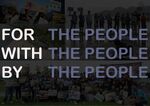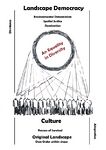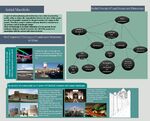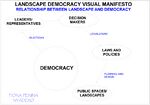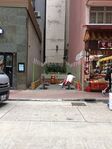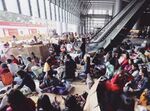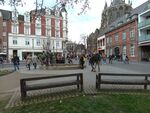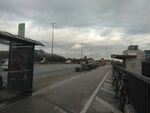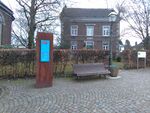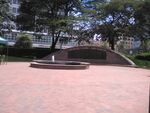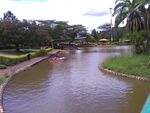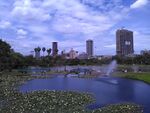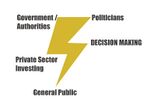LED Online Seminar 2018 - Working Group 8
--> Back to working group overview
Dear working group members. This is your group page and you will be completing the template gradually as we move through the seminar. Good luck and enjoy your collaboration!
Assignment 1 - Reading and Synthesizing Core Terminology
- You can read more details about this assignment here
- Readings are accessible via the resources page
Step 1: Your Landscape Democracy Manifestoes
Step 2: Define your readings
- Please add your readings selection for the terminology exercise before April 18:
A: Landscape and Democracy
Lynch, Kevin. (1960): The Image of the City, Cambridge, Mass.: MIT Press (STEFAN FROM MAGDEBURG / GERMANY)
Burckhardt, Lucius (1979): Why is landscape beautiful? in: Fezer/Schmitz (Eds.) Rethinking Man-made Environments (2012)(Sudhara)
B: Concepts of Participation
Davis, Mike (1990): Fortress Los Angeles: The Militarization of Urban Space , From: City of Quartz: Exca (Fiona)
LIFEscape Handbook on Participative Landscape Planning (Amir)
C: Community and Identity
Gafford, Farrah D. (2013): It Was a Real Village: Community Identity Formation Among Black Middle-Class Residents in Pontchartrain Park, Journal of Urban History 39:36 (HO SIN YEE)
Welk Von Mossner, Alexa (2014):Cinematic Landscapes , In: Topos, No. 88, 2014. (Fiona)
Culture and Changing Landscape Structure (Amir)
D: Designing
Massachusetts Institute of Technology (2013): Places in the Making: How Placemaking Builds Places and Communities (HO SIN YEE)
Kot, Douglas and Ruggeri, Deni:Westport Case Study (Fiona)
Designing with immigrants (Amir)
Hester, Randolph: Life, Liberty and the Pursuit of Sustainable Happiness (Sudhara)
E: Communicating a Vision
Goldstein, B. E., A. T. Wessells, R. Lejano, and W. Butler. 2015. Narrating Resilience: Transforming Urban Systems Through Collaborative Storytelling. Urban Studies. 52 (7): 1285-1303. (HO SIN YEE)
'Reading the Landscape' by Simon Bell, EMU Tartu (Sudhara)
Games in urban planning examples
Stadtspieler: http://www.stadtspieler.com (STEFAN FROM MAGDEBURG / GERMANY) Block By Block: http://blockbyblock.org/about (STEFAN FROM MAGDEBURG / GERMANY)
Apps, webpages, toolkits
EngagementLab - From playing games, to making media, to running campaigns https://elab.emerson.edu/about (STEFAN FROM MAGDEBURG / GERMANY)
Participedia - catalogue and compare the performance of participatory political processes https://participedia.net/en/about (STEFAN FROM MAGDEBURG / GERMANY)
Steps 3 and 4: Concepts Selection and definition
- Each group member selects three relevant concepts derived from his/her readings and synthesize them/publish them on the wiki by May 9, 2018
- Group members reflect within their groups and define their chosen concepts into a shared definition to be posted on the wiki by June 6, 2018.
- Other group members will be able to comment on the definitions until June 12, 2018
- Each group will also report on their process to come to a set of shared definitions of key landscape democracy concepts on the wiki documentation until June 20, 2018
Concepts and definitions
HO SIN YEE (Alisa)
- (C: Community and Identity) (Gafford, Farrah D. (2013): It Was a Real Village: Community Identity Formation Among Black Middle-Class Residents in Pontchartrain Park, Journal of Urban History 39:36)
CONCEPT ONE: Community and identity building depends strongly on shared childhood and adolescent memories among individuals, which are created by attending religious, cultural and family functions within the neighborhood. The resulted communal bonding can be long-lasting, and it plays an important role in the resilience of a community after traumas.
- (D: Designing) (Massachusetts Institute of Technology (2013): Places in the Making: How Placemaking Builds Places and Communities)
CONCEPT TWO: Placemaking is more about doing it but not just focusing on the planning phase. It is about trial and error, as well as improvement, which make it more powerful than the seemingly best planned solution. One important thing to note is the making process never ends, as it involves the actual usage and maintenance after the accomplishment of design and construction.
- (E: Communicating a Vision) (Goldstein, B. E., A. T. Wessells, R. Lejano, and W. Butler. 2015. Narrating Resilience: Transforming Urban Systems Through Collaborative Storytelling. Urban Studies. 52 (7): 1285-1303. )
CONCEPT THREE: Shared vision and experience among a place are enhanced by planning with different ways of understanding. Therefore, narrative is a good way to address the symbolic and subjective meanings of wellbeing, which enforcing the ability to gather various opinions and allowing self-initiated processes to decide what improvements should be done for whom.
Sudara Jayalath: ...
- Concept ONE (A:landscape democracy;mapping the terrain)_Burckhardt, Lucius (1979): Why is landscape beautiful? in: Fezer/Schmitz (Eds.) Rethinking Man-made Environments (2012)
Existence of a Landscape: "Landscape is a Construct". There is no 'absolute objective reality', where an absolute landscape exists.The existence of a landscape is relative, its relative to the perception of the observer. Perception of the observer is a production of his/her own memory, experience and knowledge. But the knowledge is a production of a particular epistemology which structured out via a specific way of thinking due to a specific cultural conditions, which are defined by landscapes.
- Concept TWO (D:Designing)_ Hester, Randolph: Life, Liberty and the Pursuit of Sustainable Happiness
Resilient Form: Adaptability, bare-ability of a human habitat called as a resilient form. A human habitat could exist in various forms according to temporal land utilization. Due to evolution of utility, functional conception or natural state a habitat have to adapt for the next state of existence. For this existing form is important. A habitat with this adaptable form can be called as a resilient form.
- Concept THREE (E:Communicating a Vision)_'Reading the Landscape' by Simon Bell, EMU Tartu
Landscape Character: Landscape is a process, series of situations, which take place one after one in to a particular order. This order has a unique, or spot specific behavior which reflects (characterize) via each situation. Each situation projected out as a combination of different layers which are dependent on each other. As some examples Geological, Geo-morphological, Ecological, Anthropological, Communication, Visual and so on. The character of a landscape is the condition, dominate characteristics of each layer in a particular time.
Author 3:Stefan Köder
- CONCEPT ONE: Concept "Five Elements" (1960) by urban theorist Kevin Lynch(A: Landscape and Democracy) (Lynch, Kevin. (1960): The Image of the City, Cambridge, Mass.: MIT Press)
Study how observers take in information of the city, and use it to make mental maps. Lynch's conclusion was that people formed mental maps of their surroundings consisting of five basic elements
Lynch's Five Elements:
1) Paths These are the streets, sidewalks, trails, canals, railroads, and other channels in which people travel; They arrange space and movement between space.
2) Edges Boundaries; They can be either Real or Perceived; These are walls, buildings, and shorelines, curbstone, streets, overpasses, etc.
3) Districts Medium to large areas that are two-dimensional; An individual enters into and out of these areas; Have common identifying characteristics.
4) Nodes Large areas you can enter, serve as the foci of the city, neighborhood, district, etc.; Offers the person in them multiple perspectives of the other core elements.
5) Landmarks Points of reference person cannot enter into; These are buildings, signs, stores, mountains, public art; Mobile Points (such as Sun) can be used as well.
Critical view on this image concept: [...] the relation of people to the city goes beyond perceptual recognition and introduces the role of ideology. In short, the inhabitant of the city does not adapt to an environment [by a perceptual knowledge of form, note from Dr. Kirsten Wagner], rather, residents play a role in the production and use of the urban milieu through urban practices."[Gottdiener, Mark; Lagopoulos, Alexandros Ph., Introduction, in: Gottdiener; Lagopoulos, The City and the Sign (wie Anm. 7), S. 1-22, here S. 7]
- CONCEPT TWO: Games (board game) as a tool: “Playful ways to a spirited society”: To promote creativity, partecipation and processes of communication, competencies and development; to inspirate and support the exchange of different interests and points of view, thematical approaches and the development of new ideas and ways of society works on an individual and a common level; for empowerment and promotion of communication and networking(E: Communicating a Vision / Games in urban planning examples) (Stadtspieler: http://www.stadtspieler.com)
These games became an official project of the UN-Decade of Education for Sustainable Development. Since 2004 these games have been tested successfully in a lot of projects in the spheres of urban and rural development, youth work and human resources development in enterprises and organisations.
Idea of the game: The city of XAGA seems to have come to a standstill. The city needs new impetus in order to give the city a vibrant future. How can one persuade investors, the citizenry and visitors to give the city development renewed energy? The municipal authorities of XAGA have a wonderful idea: All interested inhabitants and/or investors are given some pieces of land in the city. Furthermore, to enhance the renewal of the city building materials (plasticine) are provided. From this, new buildings and green areas, interesting ideas and projects are implemented. Then, if the publicity is right, the first curious visitors and inhabitants come to look at everything. Each player takes on the role of inhabitant as well investor. By actively engaging in both roles the players ensure that the city of XAGA becomes a vibrant city once more.
- CONCEPT THREE: Create an innovative programme in which Minecraft is used as a community participation tool in the design of urban public spaces. For: United Nations programme for sustainable cities. (E: Communicating a Vision / Games in urban planning examples) (Block By Block: http://blockbyblock.org/about)
Idea: Experiences from projects all over the world show that Minecraft is a great tool for involving people, particularly youth, women and slum dwellers in urban design. Through participatory design workshops, UN-Habitat and partners bring people together to visualise their ideas in Minecraft, and present these to city authorities and local government officials. The Minecraft designs are then used as part of the process of implementing real public space improvement projects.
Backgound: Block by Block is a charity set up in 2016 by Mojang and Microsoft to support UN-Habitat’s work with public space and Minecraft. The purpose of Block by Block is to raise funds for the improvement of public spaces worldwide, with a focus on poor communities in developing countries.
Author 4: ...
- ......
- .......
- .......
Author 5: ...
- ......
- .......
- .......
Step 5: Reflection
Step 6: Revised manifestoes
- please look again at your initial manifestoes and update them with any new aspects/prespectives you have taken up during this seminar
Assignment 2 - Your Landscape Symbols
- You can read more details about this assignment here
Landscape Symbols Author 1: HO SIN YEE
Landscape Symbols Author 2: Sudara Jayalath
Elements have been used as an encouragement for outdoor living, while culturing the transfer of knowledge of identity and history for everyone. The middle water feature with human figure sculptures represents the "behavior of money". This strong idea used as a public interactive supportive element, symbolize the idea of outdoor living and of this particular community while showing how all the people become a part of, the art of city. (Aachen, Germany)
Layers of mobility-scape as a representation of possibility of the existence of multiplicity and diversity of user range. And these parallel layered mobility infrastructure symbolize how the authority of the power of landscape has been distributed among all the type of potential users. (Donnersbergerbrücke,Munich)
Elements represents the ways a community find, to take place in the process of creating spaces in to places. The Book Bank, and a bench next to it symbolize the degree of ability to participation and desire to share of this particular community.And it shows their ability to adapt the landscape in to a productive place. (Aachen, Germany)
Landscape Symbols Author 3: Stefan Köder (from Magdeburg / Germany)
You can see here a reerected old windmill-powered plant. It stands outside of the small village Graupa, near the hill "Borsberg" and 30 km away from Dresden (Sachsen / Germany). It was reerected some years ago by an local craftsman, who has a carpenter's workshop in the village and scheep-run nearby. So it just transformed: from an old-style plant -and individual leisure activitie of one man- to an important landscape symbol. It is now a kind of a landmark, that gives identity(!) to a village in East Germany and people there. And became next to this a little tourism attraction and photo icon.
Sauerlandpark Hemer: New wooden tower, open accessible, built as a light-weight-construction (like a Russian prototype system of the 1920s). It stands on a 33ha wide areal from a former military park for tank exercises. This military areal ("Blücherkaserne" - Revitalisierung einer Militärbrache) was 2004 transformed to a large public park with some housing and commercial units. This project was financed and started because of a regional garden festival in 2010 (Landesgartenschau 2010, Sauerlandpark Hemer, Germany, between Köln and Dortmund). Main theme there is a park for culture and sport activities. The park is still with fences and an entrance fee. It is supported by community of Hemer but also from idealistic locals and a new founded local association.
Is this really a "Landscape Symbol"? - I think yes - as everybody could see at first sight what symbol it could be and the idea behind it. It is an artificial built zoo (built from my 7 years old son Miká). Material: paper, wooden Kapla Stones and Schleich toy animals. So it is an artificial toy landscape in an artificial surrounding (floor in the flat) but it is indeed a landscape. I guess it could be an interesting base for discussions ...so what is a "real landscape"? ...and do symbols exists also in such a small and almost private world - and even in the world of children? What is about complete artificial landscapes? What do you think? :-)
Landscape Symbols Auther 4: ...
The Karim Khan Castle is a citadel located in the downtown Shiraz, in Shahrdari square. It was built in 1180 AH. Karim Khan invited the best architects and artists of the time and bought the best materials from other cities and abroad for the construction of the castle of Karim Khan, which was quickly constructed.During the Zand dynasty it was used by the king as living quarters. During the Qajar period it was used as the governor's seat and during the Pahlavi period it was converted into a prison and the paintings were plastered over.But this building is known as the center of this space and historical element in the Shiraz municipality square with popular stories. Throughout the years, this space has created a good urban space and a crowd of people thanks to an attractive landscape and a memorable observer. Today, due to the lack of attention to this urban space and the degradation of its landscape, we make this space less so because the presence of people in space has diminished because of the lack of conformity with the opinions of the people.
The Gate was first built during the reign of 'Adud ad-Dawla. By the time of the Zand dynasty and the Qur'an was placed in it so that the travelers would be blessed with passing through it. Today the gates are part of a city park where Shirazis relax and picnic during their leisure hours. In the past by entering the city and standing under this gate, The most important religious element of the city was seen;This is a kind of respect for religious values by the people. But by changing the morphology of the city, the religious element is not visible from the gate; A phrase has been ignored with the value and belief belief of the people of the community. On the other hand, with the construction of a large hotel adjacent to and above this gate, the beauty of the gate is also lost And like the past, it's not the first entry point in the city. Also, by imposing behavioral and user constraints; Constraints that often conflict with the will of the people.
Roofing shiraz is the best place to enjoy the city's landscape that located on a hill overlooking the city.In the winter, snowfall is a beautiful landscapr from this point. The presence of high-rise buildings in different parts of the landscape has diminished. Unfortunately, the limits of commuting to this area, as well as the restrictions imposed by officers at this location, have reduced access to space.
Landscape Symbols Auther 5: Fiona Nyadero
This is the August 7th Memorial park in Nairobi, Kenya. It symbolises the ability of the city to move forward after a devastating terrorist attack at the heart of the city. In a way it is a reflection of the national anthem, which encourages us to live in peace, love and unity. We interpret the landscape to mean how much we value peace, love and unity among fellow country men and women.
Uhuru Recreational Park in Nairobi, Kenya is a park within the Central Business district in the city. It is a landmark on its own right, as it is surrounded by tall buildings and hardscapes all around. Its name is a swahili word which means freedom. The park is very historical and offers a cheap form of entertainment to the locals.
Assignment 3 - Role Play on Landscape Democracy "movers and shakers"
- You can read more details about this assignment here
Assignment 4 - Your Landscape Democracy Challenge
- You can read more details about this assignment here
- Each group member will specify a landscape democracy challenge in his/her environment
- Each Landscape Democracy Challenge should be linked to two or three of UN's 17 sustainable development Goals
Landscape Democracy Challenge 1
- Give a title to your challenge
- Yourname challenge 1.jpg
caption: why did you select this case?
- Yourname challenge 2.jpg
caption: what is the issue/conflict (1)
- Yourname challenge 3.jpg
caption: what is the issue/conflict (2)
- Yourname challenge 4.jpg
caption: who are the actors?
- Yourname challenge 5.jpg
caption: UN's Sustainable Development Goal?
- Yourname challenge 6.jpg
caption: UN's Sustainable Development Goal?
Your references:
- ...
- ...
Landscape Democracy Challenge: Sudara Jayalath
- An Energy Landscape that Steals away life
- Yourname challenge 5.jpg
caption: UN's Sustainable Development Goal?
- Yourname challenge 6.jpg
caption: UN's Sustainable Development Goal?
Your references:
- ...https://ejatlas.org/conflict/norocholai-coal-power-station
- ...http://www.dailymirror.lk/article/pro-56345.html
Landscape Democracy Challenge 3
- Give a title to your challenge
- Yourname challenge 1.jpg
caption: why did you select this case?
- Yourname challenge 2.jpg
caption: what is the issue/conflict (1)
- Yourname challenge 3.jpg
caption: what is the issue/conflict (2)
- Yourname challenge 4.jpg
caption: who are the actors?
- Yourname challenge 5.jpg
caption: UN's Sustainable Development Goal?
- Yourname challenge 6.jpg
caption: UN's Sustainable Development Goal?
Your references:
- ...
- ...
Landscape Democracy Challenge 4
- Give a title to your challenge
- Yourname challenge 1.jpg
caption: why did you select this case?
- Yourname challenge 2.jpg
caption: what is the issue/conflict (1)
- Yourname challenge 3.jpg
caption: what is the issue/conflict (2)
- Yourname challenge 4.jpg
caption: who are the actors?
- Yourname challenge 5.jpg
caption: UN's Sustainable Development Goal?
- Yourname challenge 6.jpg
caption: UN's Sustainable Development Goal?
Your references:
- ...
- ...
Landscape Democracy Challenge 5
- Give a title to your challenge
- Yourname challenge 1.jpg
caption: why did you select this case?
- Yourname challenge 2.jpg
caption: what is the issue/conflict (1)
- Yourname challenge 3.jpg
caption: what is the issue/conflict (2)
- Yourname challenge 4.jpg
caption: who are the actors?
- Yourname challenge 5.jpg
caption: UN's Sustainable Development Goal?
- Yourname challenge 6.jpg
caption: UN's Sustainable Development Goal?
Your references:
- ...
- ...
Assignment 5 - Your Democratic Change Process
- You can read more details about this assignment here
- After documenting and reflecting on your challenges you will continue jointly with one of these challenges and design a democratic change process
Your Democratic Change Process
- Add Title
- Your Democratic Change Process Slide1.jpg
caption: ...
- Your Democratic Change Process Slide2.jpg
caption: ...
- Your Democratic Change Process Slide3.jpg
caption: ...
- Your Democratic Change Process Slide4.jpg
caption: ...
Reflection
- ....
- ....
- ....
Conclusion:
- ....
- ....
- ....
Your references
- ...
- ...
- ...
